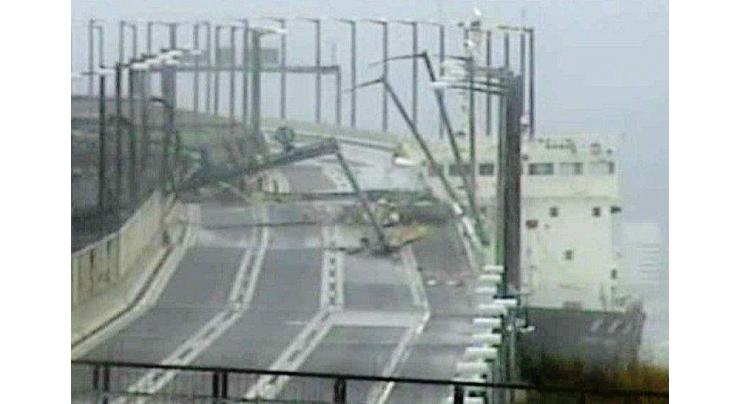
Japan Disasters Highlight Vulnerable Infrastructure
Mohammad Ali (@ChaudhryMAli88) Published September 12, 2018 | 10:39 AM

Flooded runways, thousands of passengers stranded and a tanker smashing into an access bridge: last week's typhoon in Japan highlighted the vulnerability of Kansai Airport which serves a region with an economy bigger than Belgium's.
Tokyo, (APP - UrduPoint / Pakistan Point News - 12th Sep, 2018 ) :Flooded runways, thousands of passengers stranded and a tanker smashing into an access bridge: last week's typhoon in Japan highlighted the vulnerability of Kansai Airport which serves a region with an economy bigger than Belgium's.
Because of concerns about engine noise, Kansai -- located in the bay of Osaka -- is the world's first airport entirely situated on a huge man-made island, putting it at risk of flooding, tsunamis and typhoons.
Damage to the airport is seen having a dramatic knock-on effect on tourism and trade, as it handles 22 million international passengers per year and 5.3 trillion Yen ($47 billion) of Japan's exports -- more than seven percent of the national total.
"The Osaka region which was hit by the typhoon is about 10.9 percent of Japan's GDP. It's slightly larger than Belgium and about the same as Sweden," noted Kohei Iwahara, economist at Natixis Japan Securities.
"You have the ports affected, Kansai Airport malfunctioning and the question is: how long is it going to last?" asked the expert.
One week after Typhoon Jebi ravaged western Japan, the airport is still not fully functional, with power not yet completely restored and access via the damaged bridge still not back to normal.
It has operated fewer than 100 flights in total since last Tuesday's typhoon, a far cry from the 400 per day it usually runs in its round-the-clock operation.
Kansai airport has been beset by setbacks from the beginning and has spent vast amounts on protection from the elements -- such as high walls and waterproof barriers -- which proved of limited value when the typhoon struck.
According to Mizuho Securities, the typhoon and an earthquake in the more rural island of Hokkaido has increased the danger of a cut in Japan's GDP, which came in at 0.7 percent on-quarter in April-June.
The disasters cut supply lines and could result in a 0.2-percentage point dip in factory output in the third quarter, Mizuho said.
The 6.6-magnitude Hokkaido quake knocked out the main thermal power plant, causing a total blackout for the three million households on the island and havoc for logistics. The plant will not be fully up and running until at least November.
Car giant Toyota for example was forced to stop production in the whole country because it was not being supplied with parts from its factory in Hokkaido.
Related Topics
Recent Stories

Punjab CM inaugurates Pakistan’s first Virtual Women Police Station

Dutch model Donny Roelvink embraces Islam

Experts raise concerns over introduction of 10-stick packs

Iranian president arrives in Karachi

Law Minister expresses Govt's resolve to address issue of missing persons

Rizwan’s batting order may be changed: Sources

Nawaz Sharif to visit Guangzhou exhibition in China

FM Dar not traveling to China: Foreign Office

PM takes notice of deliberate delay in tax cases

Iranian President visits Allama Iqbal’s mausoleum

Iranian President arrives in Lahore today

Currency Rate In Pakistan - Dollar, Euro, Pound, Riyal Rates On 23 April 2024
More Stories From World
-
Migrant boat capsizes off Djibouti leaving 21 dead
4 hours ago -
Tesla profits tumble 55% as EV sales under pressure
4 hours ago -
Talks on global plastic treaty begin in Canada
4 hours ago -
Migrant deportations loom after parliament passes UK-Rwanda plan
5 hours ago -
Macron in last-ditch bid to halt EU vote battering
5 hours ago -
Ukraine moves to bring military-aged men home to fight
6 hours ago
-
Asia hit hardest by climate change, extreme weather: UN weather agency
6 hours ago -
Muscles and masterpieces: Louvre offers Olympic sport sessions
6 hours ago -
Migrant boat capsizes off Djibouti leaving 16 dead
6 hours ago -
UK Rwanda law sparks fear among migrants hoping to cross Channel
8 hours ago -
China issues highest-level rainstorm warning after deadly floods
8 hours ago -
UK's Sunak announces raised defence spending, new Ukraine aid
9 hours ago